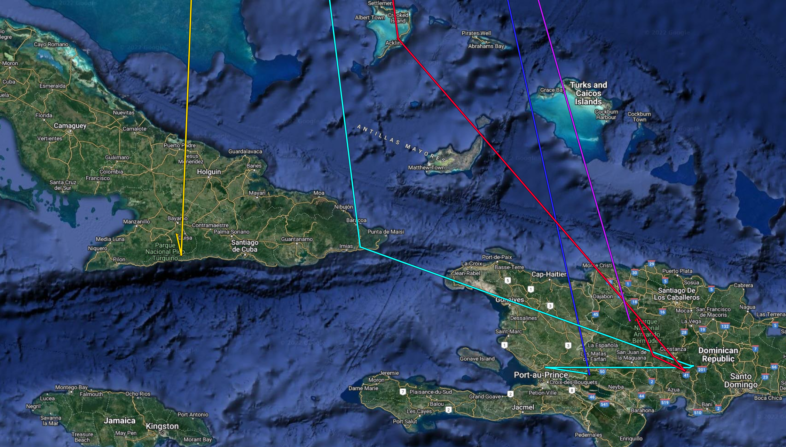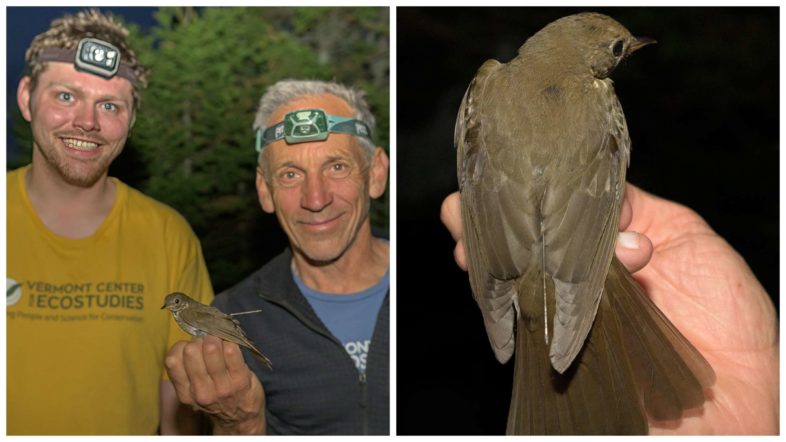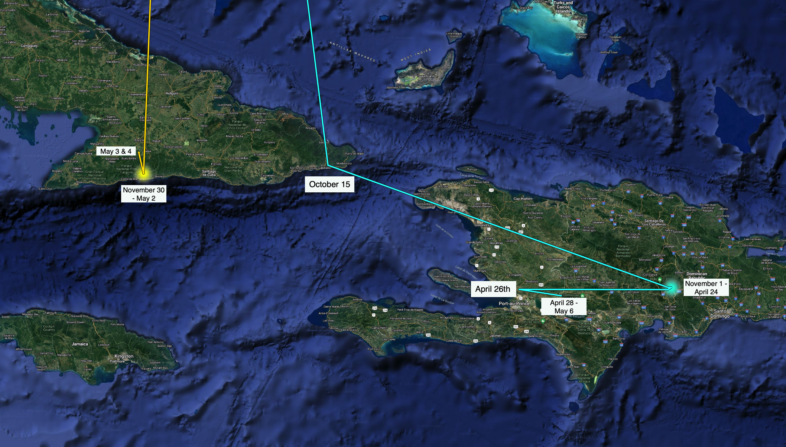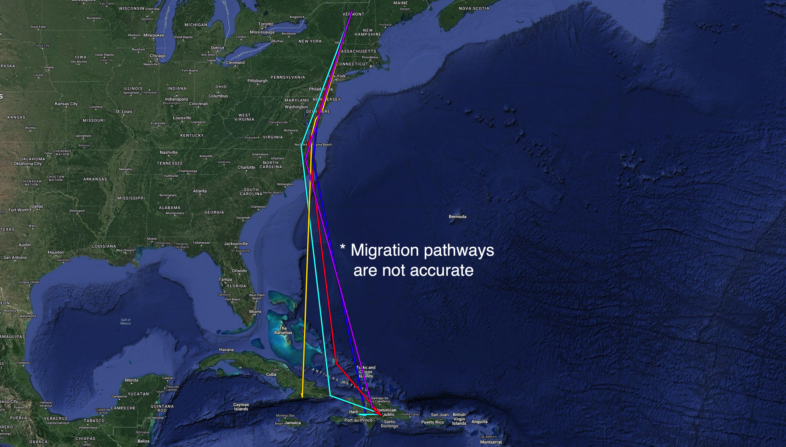
The winter tracks of 5 GPS-tagged male Bicknell’s Thrushes. Four birds overwintered primarily in the Dominican Republic, while the fifth spent late November through April in Cuba’s Sierra Maestra. All were tagged on Mt. Mansfield in June and July of 2021.
The suspense is over, the nervous tension dissolved, the thrill of scientific discovery regained. After a long 9 months of concerned waiting, as we brooded about the fate of our 36 GPS-tagged Bicknell’s Thrushes (BITH) from last summer, male #2821-79231 brought a whoop of joyous relief at 8:45 pm on May 31. Three of us VCE BITHnologists—Kevin Tolan, Nathaniel Sharp, and I—had arrived on Mt. Mansfield in early evening for our inaugural 2022 banding session. Not only were we eager to launch another season of monitoring the ridgeline’s breeding birds, we were anxious to intercept returning BITH and retrieve their tags.
With a forecast that threatened overnight rain, we set 22 mist nets on the Amherst, Lakeview and Long trails. Skies were overcast, winds light, temperatures warm, and birds quiet. A few BITH sporadically called and sang. By 8:30 pm, we had processed a dozen netted birds, including 2 new BITH, 8 Blackpoll Warblers, and a few other individuals of expected species. The BITH witching hour had arrived, and with the dusk chorus imminent, we resorted to trickery. setting up vocal playbacks at two nets. Minutes later, a check of the Canyon Trail net quelled any fears about a season devoid of backpack recoveries: an antenna clearly protruded from the back feathers of a banded BITH in the bottom trammel!
 Bicknell’s Thrush #2821-79231 (GPS tag #50463) was our first bird to yield his precious backpack and reveal his whereabouts during the previous 9-10 months. This bird (the royal blue line in map above) overwintered in the DR’s Sierra de Neiba range, © Charles Gangas
Bicknell’s Thrush #2821-79231 (GPS tag #50463) was our first bird to yield his precious backpack and reveal his whereabouts during the previous 9-10 months. This bird (the royal blue line in map above) overwintered in the DR’s Sierra de Neiba range, © Charles Gangas
This historic recovery of male BITH 2821-79231 brought both elation and relief to us banders. Banded as a yearling on 6 July 2021 and fitted with GPS tag #50463 eight days later, the bird was in robust condition, weighing in 28.8 g and with a large cloacal protuberance, indicating his readiness for breeding. We snipped off his GPS backpack and sent him on his way. Kevin immediately connected the tag to his laptop and confirmed the vitally important fact that the unit had recorded >50 GPS “fixes” (precise locations that we had programmed into the tag). Two crucial conditions had been met: (1) the bird had returned with its tag intact, and (2) the maximum amount of data had been obtained. Confirming the quality of those data (i.e., their spatial precision) would have to await Kevin’s more powerful computer at the VCE office.
The recapture of 2821-79231 was shortly followed by two other males, and an additional two the next morning. All had been banded as 2+ year-olds last June and July. After yielding their precious tags (all held 45-55 fixes), each bird was fitted with a new GPS backpack, as we are extending our study a second year, to compare BITH migratory and overwinter movements in consecutive winters. As the promised rain gained strength by 9:00 am, we closed our nets and headed down the mountain, thrilled beyond belief to have retrieved five tags on our first visit of 2022—we’d have been elated by one.
Kevin’s examination of the data a few hours later completed a trifecta. Each tag had recorded highly precise spatial coordinates! While we can only provide a cursory summary of each bird’s whereabouts at this early stage, our data show that all 5 BITH overwintered on largely stationary territories. Four set up shop in different regions of the DR, while the fifth settled in Cuba’s Sierra Maestra, where VCE recently wrapped up four winters of field surveys. This bird was migrating on or over the Delmarva Peninsula last 1 November, and had reached his cloud forest winter site at 1550 m elevation 30 days later. He remained there until 2 May, when he moved north 26 km to a much lower elevation site at 470 m, at which point his GPS battery died(!).

Winter tracks with dates of two GPS-tagged BITH that both spent some amount of time on Cuba. One bird (yellow line, #2821-79238) overwintered for > 6 months in cloud forest of Sierra Maestra ~16 km east of Pico Turquino, while a second (turquoise line, #2821-79190) stoped on the island’s easternmost tip in mid-October before continuing on to mountains of the central DR, where it stayed for nearly 6 months, then shot westward to eastern Haiti, then back to Sierra de Neiba in the DR.
A second bird (#2821-79190) made a mid-October migratory landfall on Cuba’s easternmost tip and from there moved to an overwintering site in the central DR mountains, where it remained until April 24. It then unexpectedly (to us) shifted 185 km due west on April 24 or 25 to Haiti’s Massif de La Selle, where it stayed only a day or two before reversing 51 km eastward to the DR’s Sierra de Neiba range, where its GPS battery gave out on May 6. Interestingly, our first-recovered backpack-toting BITH #2821-79231 spent the entire winter (> 6 months, from at least November 1 to May 3, when its battery died) very close to this site, only 4 km away!
And, while decidedly anticlimactic news, our first 2022 banding session, even cut short by rain on June 1, was very productive overall, with 53 mist net captures. These included 15 BITH (7 new, 8 previous year returns), 20 Blackpoll Warblers (9 new, 11 returns), 4 Yellow-rumped (Myrtle) Warblers (all new), 8 White-throated Sparrows (5 new, 3 returns), 2 Dark-eyed (Slate-colored) Juncos (1 new, 1 return), 2 American Robins (both new), and a pair of Black-throated Green Warblers.
It is impossible to adequately communicate the sense of thrill, discovery, and relief that we feel over our preliminary GPS tag results. We now know that 5 of our birds safely negotiated what is an arduous round-trip journey in the best of times, that their GPS backpacks performed flawlessly, and that we have historic data on their precise locations after leaving Mansfield last autumn. The prospect of recovering additional birds—including, we fervently hope, several of the 10 females tagged in 2021—is nothing short of exhilarating. We’ll be back on the mountain next week, and you can be sure an update will be forthcoming!


With all the bad news in the world, this exciting report cheers the heart.
Thanks so much for sharing. Marcia
That is super exciting!!
Yaay, team BITH! Just finished Ken Kaufmann’s a season on the wind, and thought of the little blackpolls you captured. Such exciting news!
Congrats! This is indeed encouraging and exciting news. Hope to visit sometime this summer!
Looking at that migration map is thrilling! Chris, the return of these GPS carrying birds and the data contained within could not go to a more deserving crew. Bicknell thrushes are indeed incredibly lucky to have you on their side. Thank you for your hard work as always.
Is science poetry? Same hopes, fears, imagination, and yes, love. : ) Bravo, also to birds whose travels we’ve just begun to glimpse! Thank you, Chris and everyone!
Very exciting! Thank you for sharing the wonderful news with all of us and thank you for all that VCE does.
Great job all of you have done over the years and glad to hear that you are off to a great start this season!
Congrats, Chris and the VCE team! This is exciting news and we’re so happy to have had the privilege of witnessing your work firsthand. Thanks for your continued dedication to help conserve this amazing bird! Best of luck in recovering more GPS backpacks!
Knowing where the BITH visited Cuba, will you be able to send local partners to do work in that area?